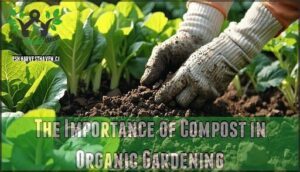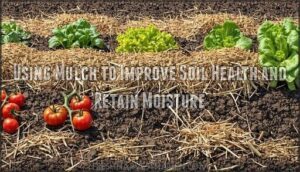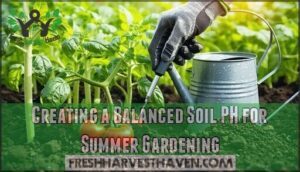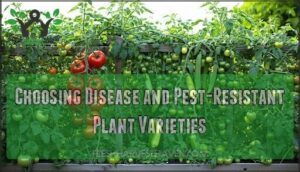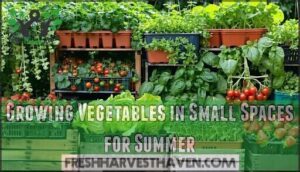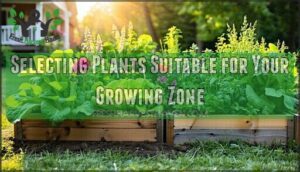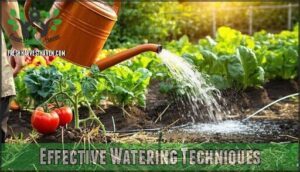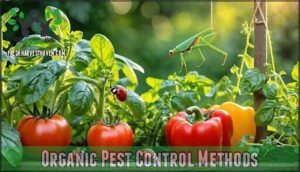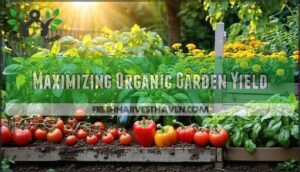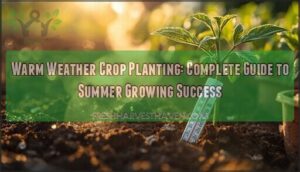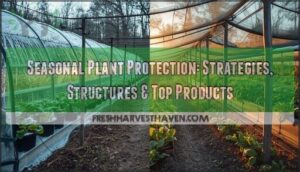This site is supported by our readers. We may earn a commission, at no cost to you, if you purchase through links.
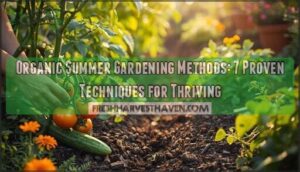
Choose heat-tolerant, disease-resistant varieties suited to your zone. Water deeply but less frequently using drip irrigation or soaker hoses to conserve moisture.
Apply organic mulch around plants to suppress weeds and retain soil moisture. Control pests naturally through companion planting, beneficial insects, and organic sprays when needed.
Feed plants with organic fertilizers like fish emulsion or compost tea. These proven techniques create a thriving ecosystem that works with nature, not against it, setting the foundation for extraordinary harvests.
Table Of Contents
- Key Takeaways
- Organic Gardening Basics
- Building Healthy Soil
- Selecting Heat Resistant Plants
- Effective Watering Techniques
- Maintaining Garden Health
- Organic Pest Control Methods
- Maximizing Organic Garden Yield
- Frequently Asked Questions (FAQs)
- What is a disadvantage of organic gardening?
- What is the easiest crop to grow organically?
- What is the difference between organic gardening and permaculture?
- What is the gardening 3 year rule?
- How do you garden organically?
- How to start a holistic garden?
- What are the standards for organic gardening?
- How do you garden in the summer?
- How can I attract pollinators to my garden?
- What are effective ways to prevent soil erosion?
- Conclusion
Key Takeaways
- Build healthy soil first – You’ll create the foundation for success by adding compost, maintaining proper pH (6.0-7.0), and using organic mulch to retain moisture and suppress weeds naturally.
- Choose heat-resistant varieties – You’ll reduce plant stress and increase yields by selecting disease-resistant, zone-appropriate plants that can handle summer’s intensity without constant intervention.
- Water efficiently with targeted methods – You’ll conserve water and prevent disease by using drip irrigation or soaker hoses, watering deeply but less frequently, and timing applications for early morning.
- Control pests naturally through integrated approaches – You’ll protect your garden without chemicals by combining companion planting, beneficial insects, organic sprays, and regular monitoring to maintain ecological balance.
Organic Gardening Basics
Starting your organic summer garden requires getting three basics right from the beginning.
You’ll need to pick the perfect sunny spot, test your soil’s health, and choose fertilizers that’ll feed your plants without harmful chemicals.
Choosing The Right Location for Your Garden
Your garden’s success hinges on selecting the perfect spot. Look for areas receiving 6-8 hours of sunlight exposure daily, as most vegetables thrive in full sun.
Success starts with finding that perfect sunny spot – your garden’s foundation for thriving vegetables.
Consider water access for convenient irrigation and guarantee proper soil drainage to prevent root rot. Evaluate space availability for your planned crops and observe microclimates around your property.
Effective garden planning means studying how sun exposure changes throughout summer, avoiding low-lying areas that collect water, and choosing locations protected from harsh winds for superior organic gardening results.
Assessing Your Soil’s Needs for Summer Gardening
Soil testing reveals your garden’s foundation story—pH levels, nutrient deficiencies, and organic matter content that determine summer success.
Test every 1-2 years to identify compaction issues and water retention capacity.
Sandy soils drain quickly but need frequent watering, while clay holds moisture but warms slowly.
Understanding these basics guides your organic soil amendments strategy effectively.
A soil test will measure plant-available nutrients to help determine the best course of action, considering summer success and water retention.
Selecting The Best Organic Fertilizers for Summer
Once you’ve checked your soil’s nutrient levels, you’ll need the right organic fertilizers to fuel summer growth.
Compost tea delivers gentle, slow-release nutrition that won’t burn plants during heat waves. Blood meal provides high nitrogen for leafy summer vegetables, while bone meal supports root development.
Animal-based fertilizers like aged manure offer balanced nutrients, whereas plant-based options like kelp meal boost micronutrients.
Match your soil testing results with these natural fertilizers for ideal plant health. These fertilizers also improve soil structure, which is essential for healthy lawns and supports overall summer growth with gentle care.
Building Healthy Soil
Building healthy soil forms the foundation of every successful organic summer garden.
You’ll discover that enriching your soil naturally creates the perfect environment for your plants to thrive during hot weather months.
The Importance of Compost in Organic Gardening
Compost transforms kitchen scraps and yard waste into black gold for your garden.
Transform your garden waste into nutrient-rich treasure that feeds plants all season long.
This organic fertilizer delivers nutrients slowly, feeding plants throughout summer while improving soil structure.
Composting methods range from simple pile systems to tumbler bins, making sustainable gardening accessible to every space.
- Compost benefits: Reduces waste by 30% while creating nutrient-rich soil amendment
- Soil enrichment: Increases water retention and provides essential minerals naturally
- Composting techniques: Hot composting breaks down materials in 3-6 months versus cold composting’s 6-12 months
- Organic gardening methods: Mix finished compost into planting holes or apply as 2-inch top dressing
Using Mulch to Improve Soil Health and Retain Moisture
Beyond composting, mulch serves as your garden’s protective blanket. Organic mulch materials like straw, wood chips, or shredded leaves create beneficial microbial activity while maintaining ideal mulch thickness of 2-4 inches.
| Mulch Type | Best Use |
|---|---|
| Straw | Vegetable gardens, moisture retention |
| Wood chips | Perennial beds, long-term soil building |
| Shredded leaves | All-purpose, quick decomposition |
Proper mulch composition feeds soil microbes as it decomposes, improving soil structure naturally. Understanding that soil microorganisms drive nutrient cycling is key to a healthy garden.
You’ll reduce watering frequency by 50% while achieving effective weed control. These sustainable gardening practices create lasting soil health improvements through continuous organic matter addition.
Creating a Balanced Soil PH for Summer Gardening
Proper soil pH testing reveals whether your garden’s foundation supports ideal nutrient uptake during summer’s demanding months.
Most vegetables thrive in slightly acidic to neutral conditions between 6.0-7.0. When summer pH adjustments become necessary, organic amendments like sulfur lower pH while lime raises it.
These plant-based and animal-based fertilizers work more effectively in balanced soil. Regular watering can shift pH levels, making ongoing organic soil management essential for sustained yield improvements.
Accurate readings require a reliable pH meter.
Selecting Heat Resistant Plants
Summer’s heat can challenge even experienced gardeners, but choosing the right plants makes all the difference in your organic garden’s success.
You’ll want to focus on varieties that naturally withstand high temperatures while resisting common summer pests and diseases, which is crucial for the garden’s success.
Choosing Disease and Pest-Resistant Plant Varieties
Smart variety selection cuts pesticide use by 60–80% while boosting yields substantially.
Look for VF or VFN codes on tomato seeds—these indicate resistance to Verticillium and Fusarium wilt.
Choose ‘Defiant PhR‘ tomatoes or ‘Dunja‘ squash for proven disease resistance.
Heirloom varieties like ‘Mississippi Purple’ southernpeas offer natural pest deterrence through beneficial insects attraction.
Growing Vegetables in Small Spaces for Summer
When summer heat intensifies, vertical gardening becomes your space-saving superpower. Container choices like stackable planters and hanging baskets maximize every square inch.
Implement intensive planting by spacing crops closer together, while succession planting guarantees continuous harvests.
Raised beds offer excellent space optimization for organic gardening practices, allowing you to grow more vegetables in less area through strategic vertical gardening techniques.
Selecting Plants Suitable for Your Growing Zone
Understanding your Zone Hardiness makes all the difference in successful summer gardening.
Check your USDA zone, then consider microclimate considerations like nearby buildings or slopes.
Visit local nurseries for expert advice on native plants that thrive in your sun exposure conditions.
These organic gardening practices guarantee companion planting success and peak seasonal harvest timing.
Effective Watering Techniques
Water management determines your organic garden’s summer success, especially when temperatures soar and rainfall becomes unpredictable.
You’ll need strategic watering techniques that conserve precious water while keeping your plants healthy and productive throughout the hottest months, using water management effectively.
Using Drip Irrigation Systems to Conserve Water
Drip irrigation delivers water directly to plant roots, using 30-50% less water than overhead methods.
These systems achieve over 90% efficiency while reducing disease by keeping leaves dry.
Install modular kits with timers for automated watering schedules.
Regular maintenance includes cleaning filters and checking for clogs.
This eco-friendly approach perfectly complements organic gardening techniques, maximizing water conservation during hot summer months.
Consider that morning watering benefits plant health and helps in water conservation with automated watering.
Collecting Rainwater for Irrigation
Capturing nature’s bounty through rainwater harvesting transforms your organic gardening methods into truly eco-friendly practices.
Install gutters and downspouts directing water into food-grade storage solutions like barrels or cisterns.
Filter collected water to maintain quality for your plants, and check local legal aspects regarding rainwater collection before implementing your system.
Regular system maintenance guarantees peak performance for sustainable watering methods.
Avoiding Overwatering in Summer Gardening
While rainwater collection offers free irrigation, you’ll need to master watering frequency to avoid drowning your plants.
Check soil moisture by inserting your finger two inches deep—if it’s wet, skip watering that day.
Focus on plant needs rather than rigid schedules.
Proper drainage solutions prevent waterlogged roots, while mulch benefits include moisture retention and reduced watering frequency.
These organic gardening solutions keep your summer garden thriving without overwatering stress.
Maintaining Garden Health
Your summer garden’s health depends on proactive care that prevents problems before they start.
You’ll maintain thriving plants by using smart mulching strategies, natural pest control methods, and beneficial insect partnerships that work together as your garden’s defense system.
Using Organic Mulch to Retain Moisture and Suppress Weeds
Mulch serves as your garden’s protective blanket, locking in precious moisture while blocking stubborn weeds.
Layer organic materials like shredded leaves or bark chips 2-3 inches deep around plants. Different mulch types offer varying decomposition rates—wood chips last longer while grass clippings break down quickly, enriching soil.
This eco-friendly gardening practice reduces watering needs substantially. Consider different types available for your specific gardening needs.
Proper application depth prevents plant suffocation while maximizing mulching benefits for thriving organic gardens, which is a key aspect of organic gardens and gardening practice.
Creating a Mulching Schedule for Summer Gardening
Building on proper mulch application, your mulching schedule determines its effectiveness throughout summer.
Time your mulch refresh strategically to maximize organic gardening benefits while addressing seasonal challenges.
Your Summer Mulching Timeline:
- Early June – Apply fresh 2-3 inch layer after soil warms completely
- Mid-July – Check application depth and add material where thinned
- Late August – Refresh decomposed areas with new organic matter
- September – Final mulch renewal before fall preparation begins
- Monthly – Monitor material selection effectiveness and adjust watering schedule accordingly
This systematic approach guarantees consistent mulch timing that supports your organic gardening best practices while managing mulch renewal needs effectively.
Practicing Natural Pest Control Using Companion Planting
Strategic companion planting creates natural pest control barriers in your organic garden.
Plant aromatic herbs like basil near tomatoes to confuse pests, while marigolds act as trap cropping magnets for harmful insects.
These plant guilds attract beneficial insects that become your garden’s security team, establishing pest confusion zones that protect vulnerable crops naturally, and create a natural barrier with trap cropping.
Using Organic Sprays to Control Pests and Diseases
When DIY sprays become your garden’s defense squad, timing and technique make all the difference.
Apply organic pesticides like neem oil or insecticidal soap during cooler morning hours for maximum spray effectiveness. These organic options require safe application—covering leaf undersides where pests hide.
You can easily find effective pest solutions online.
Chemical-free gardening demands consistent organic pest control every seven to ten days. Natural pest control works best with early intervention, making these organic gardening tips essential for summer success.
Attracting Beneficial Insects for Pest Control
Welcome beneficial insects by creating habitat with diverse insectary plants like yarrow, fennel, and sweet alyssum.
These natural predators hunt aphids, caterpillars, and other pests more effectively than pesticides.
Plant pollinator gardens with native flowers to support ladybugs, lacewings, and parasitic wasps.
This chemical-free gardening approach reduces pesticide needs while maintaining ecological balance in your organic garden ecosystem.
Organic Pest Control Methods
Summer gardens face unique pest challenges that require smart, natural solutions.
You’ll discover three powerful organic methods that protect your plants while keeping your garden safe for families and beneficial insects.
Identifying Common Garden Pests
Successful pest identification becomes your garden’s first line of defense against summer damage.
Learn to spot aphids clustering on stems, whiteflies under leaves, and spider mites creating fine webbing.
Regular damage assessment helps you catch infestations early when organic solutions work best.
Understanding pest life-cycles reveals when beneficial insects naturally appear to help control populations in your chemical-free gardening approach.
Using Organic Alternatives to Synthetic Pesticides
Once you’ve identified your garden pests, you’ll want effective organic solutions that protect your plants without harmful chemical-free gardening practices.
Natural pesticides offer safer alternatives while maintaining garden health through reduced pesticide exposure.
Here are three proven organic alternatives:
- Insecticidal soaps and horticultural oils – These smother soft-bodied insects like aphids while being gentle on beneficial insects when applied correctly.
- Diatomaceous earth – This powdery substance damages pest exoskeletons on contact, making it effective against crawling insects without toxic residues.
- Pyrethrum sprays and beneficial nematodes – Pyrethrum targets flying pests naturally, while nematodes attack soil-dwelling larvae, creating thorough organic-approved pest management for your organic gardening success.
Implementing Integrated Pest Management Techniques
Most organic gardening enthusiasts find that IPM scouting weekly during summer prevents major outbreaks.
You’ll combine biological controls like beneficial nematodes with cultural practices such as trap cropping.
Monitor pest levels using sticky traps, then apply threshold-based interventions rather than scheduled treatments.
This chemical-free gardening approach reduces pesticide use by 60% while supporting eco-friendly methods that protect beneficial insects naturally.
Maximizing Organic Garden Yield
You’ll boost your organic garden’s productivity through strategic crop rotation, smart companion planting, and consistent weed management.
These proven techniques work together to maximize your harvest while maintaining healthy soil and natural pest control.
Using Crop Rotation to Improve Soil Fertility
Beyond pest management, your garden’s long-term productivity depends on smart crop rotation. This ancient practice transforms soil health through natural processes that synthetic fertilizers can’t replicate.
Rotation benefits include:
- Nitrogen fixation from legumes feeds future crops naturally
- Soil microbes multiply when diverse plants cycle through beds
- Reduced erosion occurs as different root systems stabilize soil
- Planning rotations prevents nutrient depletion and disease buildup
Rotate plant families every three years for maximal soil health and organic farming success. Soil testing helps guarantee pH levels for nutrient availability.
Implementing Companion Planting for Increased Yield
Strategic partnerships between plants reveal nature’s secret to abundant harvests.
You’ll discover that synergistic plantings create natural pest deterrents while maximizing yield through resource partitioning.
Smart companion combinations attract beneficial pollinators and optimize space usage, making your organic farming efforts more productive than traditional monoculture approaches.
| Plant Combination | Primary Benefit |
|---|---|
| Tomatoes + Basil | Pest deterrents, flavor enhancement |
| Corn + Beans + Squash | Resource partitioning, nitrogen fixation |
| Marigolds + Vegetables | Pollinator attraction, nematode control |
| Carrots + Chives | Yield maximization, natural pest control |
| Lettuce + Radishes | Space optimization, soil aeration |
Consider heirloom seeds for companion plantings, as these varieties often work better together than hybrid alternatives.
This permaculture approach complements your crop rotation schedule while creating pollinator attractants throughout your garden space.
It also enhances the overall organic farming efforts by promoting a balanced ecosystem.
By adopting this method, you can improve your garden’s biodiversity and create a more sustainable gardening practice.
Monitoring and Controlling Weeds in Your Organic Garden
Weeds compete ruthlessly for nutrients and water, threatening your harvest.
Start with proper weed identification to target specific species effectively. Manual removal works best for small infestations, while natural herbicides like corn gluten meal prevent germination.
Soil solarization uses heat to eliminate weed seeds naturally. Cover cropping between seasons suppresses future growth.
These organic gardening methods tackle organic gardening challenges without compromising your chemical-free gardening principles, keeping organic-approved herbicides as backup options.
Frequently Asked Questions (FAQs)
What is a disadvantage of organic gardening?
You’ll face higher costs and more labor-intensive practices when choosing organic methods. Yields may be lower, and you’ll need more patience dealing with pests without synthetic chemicals.
What is the easiest crop to grow organically?
Like low-hanging fruit in life’s garden, lettuce is your golden ticket to organic success.
It’s forgiving, grows quickly, and thrives with minimal intervention, making it perfect for beginners seeking their first harvest victory.
What is the difference between organic gardening and permaculture?
Organic gardening focuses on chemical-free practices using natural fertilizers and pest control. Permaculture’s broader, designing sustainable ecosystems that mimic nature’s patterns for long-term environmental harmony and self-sufficiency.
What is the gardening 3 year rule?
Transforming your garden into an organic paradise isn’t rocket science!
The three-year rule requires you to avoid synthetic pesticides, fertilizers, and chemicals for three consecutive years before earning official organic certification from the USDA.
How do you garden organically?
You’ll grow healthy plants by using natural fertilizers like compost, avoiding synthetic pesticides, rotating crops yearly, and encouraging beneficial insects through companion planting and diverse plant selections.
How to start a holistic garden?
Think of your yard as a blank canvas waiting for nature’s masterpiece.
Start by testing your soil’s pH and nutrients, then add compost to create a rich foundation.
Choose native plants, practice companion planting, and embrace natural pest control methods.
What are the standards for organic gardening?
You’ll need to avoid synthetic pesticides, fertilizers, and GMOs while using natural alternatives like compost, crop rotation, and beneficial insects. USDA organic standards require third-party certification for commercial operations.
How do you garden in the summer?
Summer gardening mirrors a conductor orchestrating nature’s symphony—you’ll balance water, timing, and protection.
Water deeply in early morning, mulch heavily, provide shade for delicate plants, and harvest frequently to encourage continued production.
How can I attract pollinators to my garden?
Plant native wildflowers, herbs like lavender and basil, and colorful blooms such as zinnias and sunflowers. You’ll create a pollinator paradise that buzzes with activity all season long.
What are effective ways to prevent soil erosion?
Use ground cover plants, mulch heavily, create terraced beds on slopes, plant native grasses with deep roots, and install rain gardens to capture runoff naturally.
Conclusion
Success in organic summer gardening methods isn’t rocket science—it’s about working smarter, not harder.
You’ve learned seven proven techniques that transform ordinary plots into productive havens.
By building healthy soil, choosing heat-resistant plants, and implementing natural pest control, you’re creating a self-sustaining ecosystem.
These organic summer gardening methods reduce maintenance while boosting yields.
Start small, stay consistent, and watch your garden flourish naturally throughout the hottest months.

